Content for TS 23.434 Word version: 19.4.2
0…
6…
8…
9…
9.3…
9.3.3…
9.3.8…
9.3.13…
9.3.20…
9.3.23…
9.4…
10…
10.3…
10.3.3…
10.3.7…
10.4…
11…
12…
13…
14…
14.3…
14.3.3
14.3.4
14.3.4A…
14.3.4A.5…
14.3.4A.8…
14.3.5…
14.3.9…
14.4…
15…
17…
18…
A…
14.3.9 Establishing communication with application service requirements
14.3.10 AF influence URSP procedure for reliable transmission
14.3.11 VAL services over 5GS supporting EPS interworking
14.3.12 UE unified traffic pattern and monitoring management
14.3.13 Background Data Transfer configuration
...
...
14.3.9 Establishing communication with application service requirements |R18| p. 297
14.3.9.1 General p. 297
The NRM client and the NRM server (acting as an AS) are involved in the exchange and analysis of the desired service requirements (e.g. packet size, packet transmission interval, reliability, packet error rate) for the E2E communication amongst the Vertical UEs. The NRM server triggers the establishment of application-level direct service connectivity between two UEs via Uu, based on the information provided by the UEs and static configuration information available to the NRM server prior to the UE interaction. Note that service connectivity among VAL clients is established over the Uu, without device-to-device direct radio connectivity (e.g. PC5) requirement.
14.3.9.2 Procedures p. 297
14.3.9.2.1 Procedure triggered by correlated source and destination requests p. 297
The procedure for establishing Uu-based application-level direct communications between two UEs, with application service requirements is as illustrated in Figure 14.3.9.2.1-1. In this procedure the source and destination VAL clients correlate their triggering of the procedure establishment before the NRM Server provides the service.
Pre-conditions:
- NRM client 1 and NRM client 2 are provided configuration information for the VAL clients served e.g. connectivity requirements, which destination UEs to connect to over Uu, etc.
- The NRM client 1 and NRM client 2 are configured with the information of the NRM server and have connectivity enabled to communicate with the NRM server. The information is provided via pre-configuration.
- The NRM server is configured with policies and information of the UEs to determine authorization of the UEs requesting connectivity via Uu.
- The VAL clients associated with NRM client 1 and NRM client 2 have triggered the establishment of connectivity.
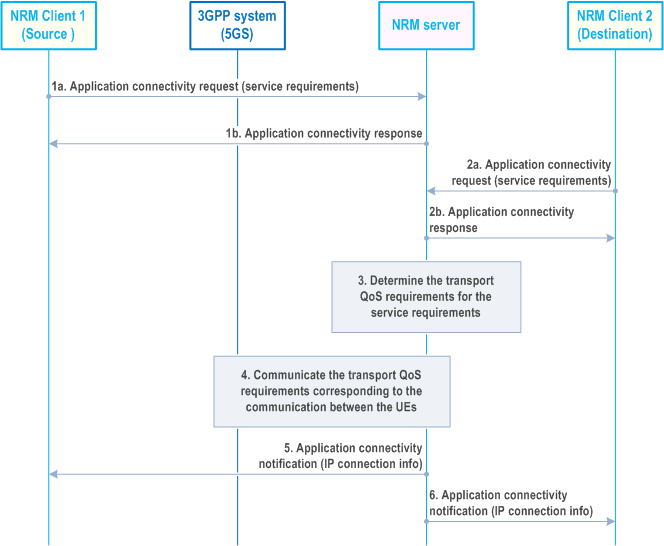
Step 1a.
The NRM client 1 sends the application connectivity request (source identity and IP address, destination identities, service requirements) to the NRM Server. The service requirement from the source includes packet size, packet transmission interval, packet E2E latency, allowed packet loss rate/packet loss amount/packet error rate, etc. The destination may be multiple UEs (devices). The identity of source and destination may be the application user identity or the MAC address.
Step 1b.
The NRM server determines whether the UE of NRM client 1 is authorized to connect to the destination UEs for direct service communications via Uu. If UE of NRM client 1 is authorized to connect to the destination UEs, then a response is provided to the NRM client 1 indicating acceptance of the request.
Step 2a.
The NRM client 2 sends the application connectivity request (destination identity and IP address, source identity, service requirements) to the NRM server. The service requirements from the destination includes the service requirements as described in step 1a.
Step 2b.
The NRM server determines whether the UE of NRM client 2 is authorized to connect to the destination UEs for direct service communications via Uu. If UE of NRM client 2 is authorized to connect to the destination UEs, then a response is provided to the NRM client 2 indicating acceptance of the request.
Step 3.
Based on the service requirements received in step 1 and step 2, the NRM server determines the parameters and patterns for direct service connectivity between the source UE and the destination UE via Uu and also the transport requirements (i.e., QoS requirements for the 3GPP system (e.g. 5GS)). Further, the NRM server derives the individual QoS requirements for the source UE and the destination UE from the transport requirement accordingly, i.e., the QoS requirements required between the source UE of NRM client 1 and the 3GPP network and the QoS requirements required between the destination UE of NRM client 2 and the 3GPP network. This step may also include retrieving the direct link status of the UEs (e.g. PDU Session Status, UE reachability). If the NRM server determines that direct service connectivity via Uu is not authorized or not possible with the given connectivity requirements, it skips step 4 and proceeds to steps 5 and 6, informing each NRM client accordingly.
NRM server will process E2E connectivity establishment between NRM client 1 and NRM client 2 only after it receives the request from NRM client 2. There can be several NRM clients (destinations) which will perform step 2 and NRM server will process their E2E connectivity with NRM client 1 (source) as and when the requests are received by the NRM server.
Step 4.
The NRM server triggers 3GPP system to establish QoS flow between the UE of NRM client 1 and the 3GPP network and the QoS flow between the UE of NRM client 2 and the network with individual QoS requirements derived from step 3 followed the procedure as specified in TS 23.502, TS 23.501.
Step 5.
The NRM server sends the application connectivity notification (connectivity/session information) to NRM client 1 indicating successful establishment of the connectivity. The connectivity/session information may contain the accepted destination identities.
Step 6.
The NRM server sends the application connectivity notification (connectivity/session information) to NRM client 2 indicating successful establishment of the connectivity.
14.3.9.2.2 Procedure triggered by source request and coordinated with destination p. 298
This procedure is used for establishing Uu-based application-level direct communications between two UEs, based on a single client initiating and providing application requirements. The procedure is as illustrated in Figure 14.3.9.2.2-1. The NRM Server provides the service by coordinating with the destination client.
Pre-conditions:
- NRM client 1 and NRM client 2 are provided configuration information for the VAL clients served e.g. connectivity requirements, etc.
- Pre-processing determines that network assisted UE-to-UE communications is required. VAL application policies and destination information for NRM clients are available at the NRM server.
- The VAL client associated with NRM client 1 triggers the establishment of connectivity and provides information about (one or more) destination VAL client(s).
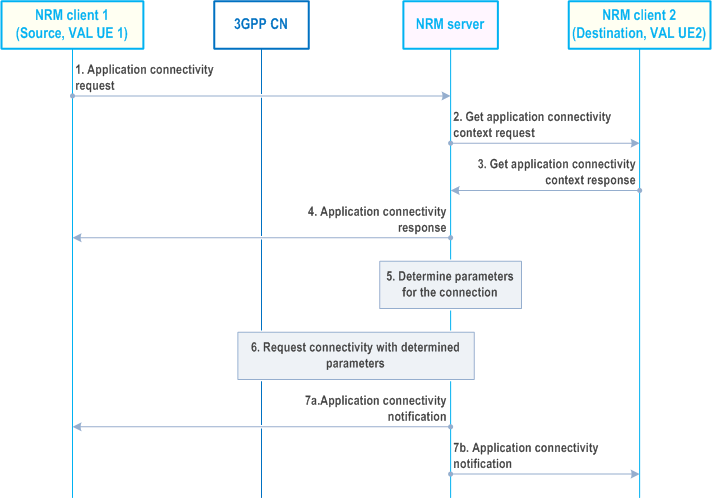
Step 1.
Each NRM client notifies the corresponding VAL client of the established application-level direct UE-to-UE connection.
The NRM client 1 sends the application connectivity request (source identity and IP address, destination identities, application requirements) to the NRM server to establish connectivity for VAL client 1 on UE 1. The destination VAL client(s) may be hosted on one or multiple UEs (devices).
Step 2.
The NRM server determines whether VAL client 1 is authorized to connect to VAL client 2 for application-level direct UE-to-UE communications. If VAL client 1 is authorized to connect to VAL client 2, the NRM server performs the get application connectivity context request to retrieve VAL UE-to-UE connection coordination context procedure as described in clause 14.3.2.56. This step can be skipped if the NRM server is already aware of VAL client 2's context information.
Step 3.
The NRM client 2 sends the get application connectivity context response to the NRM server 2. Using the request information and local policies, the NRM client 2 determines whether context information is to be provided for establishing application-level direct connectivity to the counterpart UE for the VAL application indicated. If the NRM client determines that context information is to be provided, it responds to the NRM server and provides the VAL connection coordination context data for the VAL client served.
Step 4.
The NRM server sends the application connectivity response to NRM client 1.
Step 5.
The NRM server uses VAL client 1's and VAL client 2's context information, their application-level direct UE-to-UE connectivity requirements, location information, and network context as input, checks connectivity service policies, and determines the parameters and patterns for application-level direct UE-to-UE connectivity between the VAL clients. The NRM server may also determine transport requirements (e.g. QoS requirements, for the 3GPP system (e.g. 5GS)). Further, the NRM server derives the individual QoS requirements for the source UE and the destination UE from the transport requirement accordingly, i.e., the QoS requirements required between the source UE of NRM client 1 and the 3GPP network and the QoS requirements required between the destination UE of NRM client 2 and the 3GPP network.
If network provided location information is used, location information may be obtained from the SEAL location management server. Alternatively, Location Reporting monitoring as described in TS 23.502 may be used. This step may also include a request for direct link status (e.g. PDU Session Status, UE reachability, etc. as described in TS 23.502). This action may be skipped if the clients provide location information or if there are no location requirements for establishing the application-level direct UE-to-UE connectivity.
If the NRM server determines that UE-to-UE application-level direct connectivity is not authorized or not possible with the given connectivity requirements, it skips step 5 and proceeds to steps 6 and 7, informing each NRM client accordingly.
Step 6.
The NRM server may request the 3GPP system to establish or modify the QoS flow between the source UE and the network, and the QoS flow between the destination UE and the network that enables the application-level direct UE-to-UE connection for VAL client 1 and VAL client 2 services, e.g. via modification of existing radio bearers. NRM server provides the necessary information (e.g. identifiers of VAL client 1 and VAL client 2, transport requirements) in this request message as per the procedure as specified in TS 23.502, TS 23.501.
Step 7.
a. The NRM server notifies NRM client 1 of the established UE-to-UE connection b. The NRM server notifies the NRM client 2 of the established UE-to-UE connection.
14.3.10 AF influence URSP procedure for reliable transmission |R18| p. 300
14.3.10.1 General p. 300
The procedures related to the AF influence URSP for reliable transmission are described in the following subclauses.
14.3.10.2 AF influence URSP procedure for reliable transmission p. 300
Pre-conditions:
- The SEALDD server (or VAL server) has decided to use reliable transmission for a specific SEALDD client (or VAL client) and has got the UE address or UE ID.
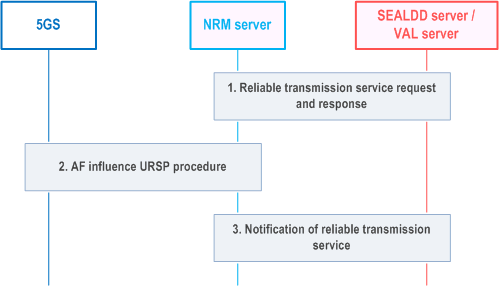
Step 1.
The NRM server receives from the SEALDD server (or VAL server) about the request for reliable transmission service with the application descriptors for the two redundant transmission paths. The SEALDD client's current UE address or UE ID is also provided to identify the affected UE.
Step 2.
After receiving the request from SEALDD server (or VAL server), the NRM server associates the available DNN and S-NSSAI information for the two application descriptors. NRM server triggers via N5/N33 with the AF guidance for URSP procedure as described in clause 4.15.6.10 of TS 23.502. The AF request includes the application traffic descriptors and the associated DNN, S-NSSAI, and also includes UE address or UE ID received in step 1.
Step 3.
NRM server sends response about reliable transmission service.
14.3.11 VAL services over 5GS supporting EPS interworking |R18| p. 301
The VAL server consumes the network resource management services from the NRM server. As specified in TS 23.501, a dedicated user plane anchor point, i.e. UPF + PGW-U function, is defined for interworking between 5GS and EPS. This enables that the network can directly handle PDU sessions (in 5GS) and PDN connections (in EPS) associated to VAL service sessions of a VAL UE during inter-system mobility.
The inter-system mobility of a VAL UE will be transparent to the NRM server and VAL server. The NRM server will continue interacting with the same control plane functions, e.g. PCF, and the VAL server will continue interacting with the same user plane function, e.g. UPF + PGW-U.
14.3.12 UE unified traffic pattern and monitoring management |R18| p. 301
14.3.12.1 General p. 301
UE unified traffic pattern and monitoring management procedures allow NRM to offer services leveraging CN exposure APIs for network parameter values configuration and UE monitoring event management.
14.3.12.2 UE unified traffic pattern and monitoring management subscription procedure |R19| p. 301
VAL servers can indicate to the NRM server interest in receiving UE unified traffic patterns and monitoring management services by sending the UE unified traffic pattern and monitoring management subscription requests.
The subscription requests from each VAL server also include the traffic pattern configuration of the requester, which refers to application-level patterns of data traffic. The NRM server aggregates the traffic patterns obtained from the requestors (and described in Table 14.3.2.53-2) to determine the UE unified traffic patterns per UE. The UE unified traffic patterns are described via Table 14.3.2.55-1 for the UE unified traffic pattern update notification. These aggregated traffic patterns per UE (termed UE unified traffic pattern) are updated/adjusted by the NRM Server based on information obtained from UE monitoring.
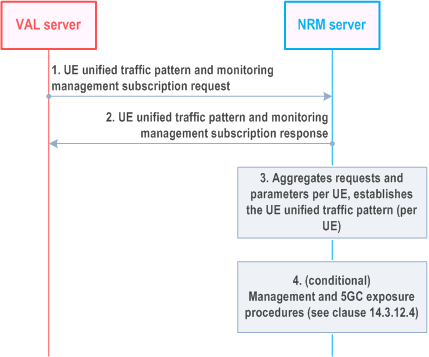
Step 1.
In order to subscribe to the NRM Server services, the VAL server sends the UE unified traffic pattern and monitoring management subscription request, as detailed in clause 14.3.2.53. The subscription request may include traffic pattern configuration, which provides the traffic patterns of the specific VAL Server. The request may also include Management subscription indications which indicate to the NRM Server which management and 5GC exposure procedures the VAL server allows the NRM Server to perform on its behalf.
Step 2.
Upon receipt of the request, the NRM server sends a UE unified traffic pattern and monitoring management subscription response as detailed in clause 14.3.2.54.
Step 3.
The NRM Server aggregates UE unified traffic pattern and monitoring management subscription requests from different VAL servers and determines the UE unified traffic pattern per UE (using the traffic patterns of all the communicating with the UE).
Step 4.
Depending on the subscription requests received and local policies, the NRM Server executes one or more management and 5GC exposure procedure (per UE). Management and 5GC exposure procedures are detailed in clause 14.3.12.4.
The NRM Server determines the management procedures required to be executed on behalf of the VAL Servers based on the received management subscription indications as follows:
- If the UE unified traffic pattern monitoring management indication is provided, the NRM Server executes steps 1-3 of the UE unified traffic pattern monitoring procedure detailed in clause 14.3.12.4.2.
- If the UE unified traffic pattern monitoring update notification indication is provided, the NRM Server executes the steps 1-4 of the UE unified traffic pattern monitoring procedure detailed in clause 14.3.12.4.2.
- If the Network parameter coordination indication is provided, the NRM executes the network parameter coordination procedure detailed in clause 14.3.12.4.3.
14.3.12.3 UE unified traffic pattern update notification procedure p. 303
An NRM Server can provide updated UE unified traffic pattern information to VAL servers by sending UE unified traffic pattern update notifications as shown in Figure 14.3.12.3-1. The UE unified traffic pattern management procedure detailed in clause 14.3.12.4.2. is an example of procedure which may result in UE unified traffic pattern updates at the NRM server, based on which UE unified traffic pattern update notifications are provided.
Pre-conditions:
- The VAL server has subscribed for UE unified traffic pattern and monitoring management services, requesting to receive UE unified traffic pattern update notifications.

Step 1.
The NRM server sends the UE unified traffic pattern update notification when either of the following occurs:
- Monitoring events lead to updates in the UE unified traffic pattern (e.g., to schedule elements in Table 14.3.2.55-1) the NRM server sends a corresponding notification to the VAL server. Other notifications may be provided, e.g., if the stationary indication changes.
- An NP Configuration Notification is received with a new set of applied network parameters and if the NRM Server determines that the new configuration is incompatible with the current UE unified traffic pattern (see also clause 14.3.12.4.2 step 3).
14.3.12.4 Management and 5GC exposure procedures p. 303
14.3.12.4.1 General p. 303
The management and 5GC exposure procedures in this clause show NRM processing and its interactions with 5GC in support of the functionality described in clause 14.3.12.2.
14.3.12.4.2 UE unified traffic pattern management procedure p. 303
The UE unified traffic pattern management procedure is used to determine and manage a unified traffic pattern applicable to a specified UE. The NRM Server then uses the 5GC exposure of UE monitoring events to update the UE unified traffic pattern.
Pre-conditions:
-
The NRM Server determines to provide the service for a specific UE if either of the following conditions is true:
- It receives UE unified traffic pattern monitoring management indications in UE unified traffic pattern and monitoring management subscription requests; or
- It determines to provide Network parameter coordination services for the UE.
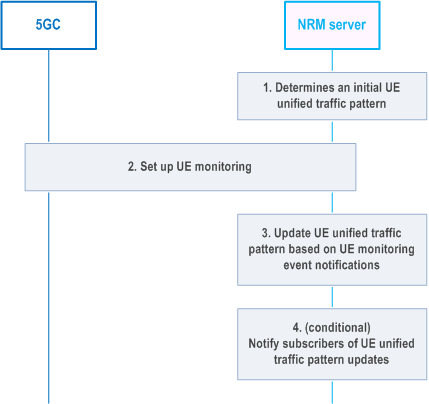
Step 1.
The NRM Server determines an initial UE unified traffic pattern, e.g. by using all Traffic pattern configurations received for the UE .
Step 2.
The NRM Server determines, based on local policy that UE monitoring events are to be configured and executes the corresponding Monitoring procedure as described in clause 4.4.2 of TS 29.122.
Step 3.
The NRM Server updates the UE unified traffic pattern based on the received monitoring events as follows:
Step 4.
- If a Monitoring Notification report for UE_REACHABILITY is received, and idleStatusInfo information is provided in the report, the NRM Server changes the schedule element of the UE unified traffic pattern such that the duration of activity is set to the value of the activeTime parameter configured in the idleStatusInfo.
- If a Monitoring Notification report for AVAILABILITY_AFTER_DDN_FAILURE is received after UEs transition to idle mode, the NRM Server updates the schedule element of the UE unified traffic pattern such that: the start of an activity window is based on the Idle Timestamp, with a periodicity equal to the TAU/RAU Timer; the duration of the activity window indicates the Active Time value.
- If a Monitoring Notification report for COMMUNICATION_FAILURE is received The NRM updates the schedule element of the UE unified traffic pattern to indicate that no communications are currently available (e.g. by using a keyword such as "NULL"). Local policies may specify events/ thresholds further defining when the NRM may provide a UE unified traffic pattern update based on monitoring events. For example, the update may be provided only after repeated communication failures are received within a timespan, or only if high reliability communications are expected. It is recommended that UE Reachability monitoring is also enabled in conjunction with the Communication Failure monitoring. This enables the NRM to provide updated timing information once the UE becomes reachable again.
- If a Monitoring Notification report for LOSS_OF_CONNECTIVITY is received, the NRM Server changes the schedule element of the UE unified traffic pattern to indicate that no communications are currently available.
Conditional: The NRM Server notifies subscribers of the UE unified traffic pattern updates, as described in clause 14.3.2.55
14.3.12.4.3 Network parameter coordination procedure p. 305
The network parameter coordination procedure uses UE unified traffic pattern information to influence aspects of UE/network behaviour such as the UE's PSM and extended idle mode DR14. For this purpose, parameter values may be suggested for Maximum Latency and Maximum Response Time for a UE. 5GC may choose to accept, reject or modify the suggested configuration parameter value.
Pre-conditions:
- The NRM Server determines to provide the service for a specific UE after receiving Network parameter coordination indications in UE unified traffic pattern and monitoring management subscription requests, subject to policy.
- The NRM Server determines and manages UE unified traffic patterns as described in clause 14.3.12.4.2.
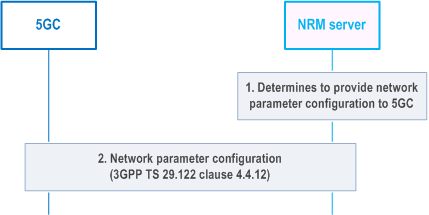
Step 1.
The NRM Server determines to provide Network parameter configuration to 5GC. This determination can be based on updates to the UE unified traffic patterns resulting from interactions with VAL Servers (e.g. Traffic pattern configuration updates), on local policies, etc.
The NRM Server determines parameters the needed for NpConfiguration data structure as specified in TS 29.122 from the UE unified traffic patterns as follows:
Step 2.
- maximumLatency - This value tells the network how long the UE is allowed to sleep. Setting it to 0 will disable PSM, extended idle mode DRX, and extended buffering. The NRM Server can extract the periodicity derived from the UE unified traffic pattern, which includes the schedule elements for the UEs communications with all VAL servers. The NRM Server sets Maximum Latency to be approximately the periodicity of the active periods derived from the schedule element of the UE unified traffic pattern.
- maximumResponseTime - When the UE uses PSM, Maximum Response Time tells the network how long the UE should stay reachable after a transition to idle. When the UE uses eDRX, Maximum Response Time is used by the network to determine when to send a reachability notification before a UE's paging occasion. The NRM Server extracts a duration of activity from the schedule element of the UE unified traffic pattern and sets Maximum Response Time to reflect the duration of activity, indicating how long the UE should stay reachable for downlink communications.
The NRM Server performs the Network Parameter Configuration procedure as described in clause 4.4.12 of TS 29.122.
14.3.13 Background Data Transfer configuration |R18| p. 306
14.3.13.1 General p. 306
The Background Data Transfer (BDT) feature requires an initial step in which BDT policies are requested and negotiated. BDT Policy requests to the 3GPP network are based on an expected time window, expected data volume per UE and UE set, with additional optional information e.g., network area information. The UE set is indicated as an expected number of UEs, and optionally a VAL group ID or a list of VAL UE IDs.
The feature allows for the NRM server involved to negotiate the BDT policies proposed by the network. It also allows the NRM server to enable notifications to be sent, should network conditions affect future BDT policies.
Based on the BDT policies obtained using the procedures detailed in this clause, a VAL server can initiate a data transfer to the client and/or the VAL client can initiate a data transfer to the VAL server at the negotiated time and with the negotiated charging rates. The data transfer between the VAL Server and the VAL Client is performed without NRM Server enablement. Service layer functionality for the purpose of facilitating the data transfer with the negotiated BDT policy is not in scope of this specification.
14.3.13.2 Request and Select Background Data Transfer Policy p. 306
Figure 14.3.13.2-1 depicts a general procedure for the request and configuration of traffic policies for BDT initiated by a request from a VAL Server.
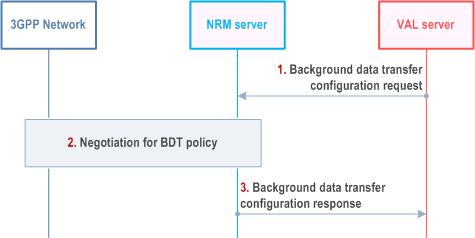
Step 1.
A VAL Server requests the NRM Server to negotiate with the 3GPP network a background data transfer policy using the BDT_Configuration_request (see clause 14.4.2.15).
The request includes expected data volume per UE, expected number of UEs, expected time window for the background data transfer. The request may also include group ID, geographic information for the UEs, application traffic descriptors, a request expiration time, guidance for policy selection. If guidance for policy selection is not included, the NRM Server may choose independently from among multiple transfer policies, depending on local and ASP-provided policies.
Step 2.
Based on the request expiration time and Service Provider policies, NRM Server may determine to delay interactions with the 3GPP network in order to negotiate on behalf of multiple VAL Servers.
The NRM Server performs the procedure for negotiation of background data transfer policy as described in clause 4.16.7.2 of TS 23.502. The procedure requires that expected data volume per UE, expected number of UEs, and expected time window are provided by the NRM Server. If the NRM Server determines to negotiate on behalf of multiple VAL Servers, the parameters included reflects a superset of the individual VAL Server requests.
The 3GPP network determines one or more applicable BDT policies based on the requesting Background Data Transfer parameters. A list of BDT policies and a mandatory BDT Reference ID is provided to the NRM Server. Each BDT policy includes charging rating group reference and allocated time window and optional maximum UL and DL aggregated bandwidth as specified by TS 23.503. The NRM Server uses ASP policies and the transfer selection guidance (if available) to select a BDT policy. The NRM Server informs the 3GPP Network of the selected BDT policy.
Step 3.
The NRM Server stores the BDT configuration information with the information received from VAL server in step 1 along with the BDT Reference ID and selected BDT policy. The NRM server responds to the VAL Server, providing the BDT Reference ID and allocated time window of the selected background data transfer policy.
14.3.13.3 Reselect Background Data Transfer Policy p. 307
Figure 14.3.13.3-1 depicts a general procedure for reselecting BDT policies after BDT warning.
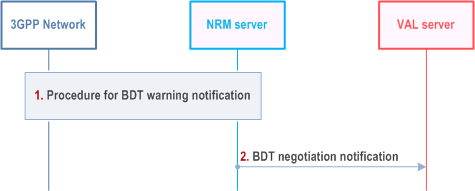
Step 1.
The 3GPP Network, via NEF, sends the BDT warning (BDT Policy negotiate) notification to the NRM server as specified in step 10, clause 4.16.7.3 of TS 23.502. The notification includes the affected BDT Reference ID and list of candidate BDT policies.
Each of the BDT policies in the candidate BDT list includes charging rating group reference and time window, as well as optional maximum UL and DL aggregated bandwidth.
The NRM Server checks the new BDT policies included in the candidate list of the BDT warning notification. The NRM Server determines whether the notification affects multiple VAL Servers or not. The NRM Server uses ASP policies and the transfer selection guidance (if available) provided with the initial VAL Server request to select a policy.
The NRM Server informs the 3GPP Network of the selected transfer policy or that no new policy has been selected by using steps 11-16 of the procedure for BDT warning notification in clause 4.16.7.3 of TS 23.502.
Step 2.
The NRM server updates the BDT configuration information with the newly selected BDT policy or no BDT policy is selected for the BDT Reference ID. The NRM Server sends a BDT_Negotiation_notification (see clause 14.4.2.16), to the VAL server, providing information about the newly selected BDT policy, if the granted time window changes or that no BDT policy is selected for the BDT Reference ID. If a new BDT policy affecting the granted time window is selected by the NRM server, the information provided to the VAL Server includes the BDT Reference ID and the granted time window.
14.3.13.4 BDT configuration get p. 308
Figure 14.3.13.4-1 illustrates a procedure for retrieving the BDT configuration on the NRM server by the VAL server.
Pre-conditions:
- The VAL server has performed the BDT configuration request as specified in clause 14.3.13.2.
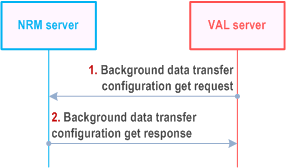
Step 1.
A VAL Server requests the NRM Server to retrieve its background data transfer policy configuration using the BDT_Configuration_Get_request (see clause 14.4.2.19).
The request includes identifier for the BDT policy configuration stored at the NRM server.
Step 2.
The NRM Server provides a response to the VAL server indicating success or failure of the operation and the BDT configuration data available at the NRM server.
14.3.13.5 BDT configuration update p. 308
Figure 14.3.13.5-1 illustrates a procedure for updating the BDT configuration on the NRM server by the VAL server.
Pre-conditions:
- The VAL server has performed the BDT configuration request as specified in clause 14.3.13.2.
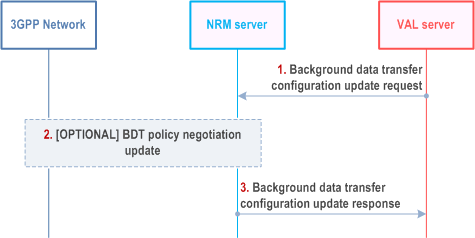
Step 1.
A VAL Server requests the NRM Server to update its background data transfer policy configuration using the BDT_Configuration_Update_request (see clause 14.4.2.20).
The request includes identifier for the BDT policy configuration stored at the NRM server and one or more updated information like expected data volume per UE, expected number of UEs, expected time window for the background data transfer, geographic information for the UEs, a request expiration time, guidance for policy selection.
Step 2.
The NRM Server may perform the BDT policy negotiation as specified in clause 4.16.7.2 of TS 23.502. The request for update of the BDT policy configuration by the VAL server may impact the selected BDT policy.
Step 3.
The NRM Server provides a response to the VAL server indicating success or failure of the operation.
14.3.13.6 BDT configuration delete p. 309
Figure 14.3.13.6-1 illustrates a procedure for deleting the BDT configuration on the NRM server by the VAL server.
Pre-conditions:
- The VAL server has performed the BDT configuration request as specified in clause 14.3.13.2.
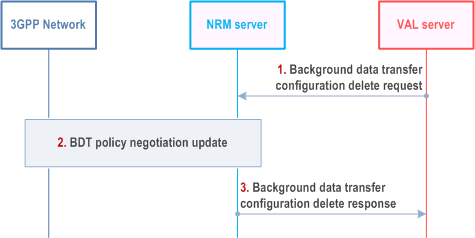
Step 1.
A VAL Server requests the NRM Server to delete its background data transfer policy configuration using the BDT_Configuration_delete_request (see clause 14.4.2.21).
The request includes identifier for the BDT policy configuration stored at the NRM server.
Step 2.
The NRM Server may perform the BDT policy negotiation update as specified in clause 4.16.7.2 of TS 23.502. If NRM server is currently serving only one VAL server, then BDT policy update is performed as specified in clause 4.16.7.3 of TS 23.502. The request for deletion of the BDT policy configuration by the VAL server removes the requirement of the VAL server and/or the VAL UE or group of VAL UEs to perform BDT.
Step 3.
The NRM Server provides a response to the VAL server indicating success or failure of the operation.
14.3.14.1 General |R19| p. 310
A service may initiate a device trigger to a UE to cause it, for example, to connect to a VAL server, to provide updated information, etc.
14.3.14.2 Device Triggering via NRM procedure |R19| p. 310
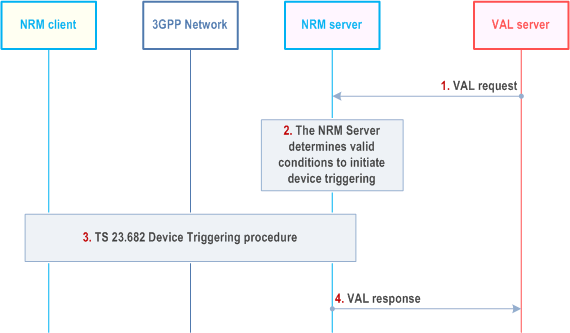
Step 1.
Based on the trigger purpose derived from the payload, the targeted NRM Client or VAL Client performs the corresponding actions (e.g., connect to the VAL Server).
The device triggering procedure is initiated by an API request from a VAL Server.
Step 2.
The NRM Server determines the valid conditions to initiate the device triggering procedure with the CN. The determination is based on request parameters as follows:
Step 3.
- If "Time Window" IE is present, the NRM Server includes its value to limit the conditions considered as valid based on step a) and/or to determine the trigger validity time value for the CN API request.
- If "Area information" IE is present, the NRM Server includes its value to limit the conditions considered as valid based on step b)
The NRM Server performs the device triggering procedure described in clause 5.2 of TS 23.682. The procedure requires that the UE Identifier, port number(s) and protocol information are available at the NRM Server. The trigger may be sent to ensure that a target UE in PSM mode is reachable when application communications resume.
As part of the procedure, the NRM Server receives a Device Triggering delivery status report from SCEF/NEF indicating the success of the delivery.
Step 4.
The NRM Server responds to the step 1 request.